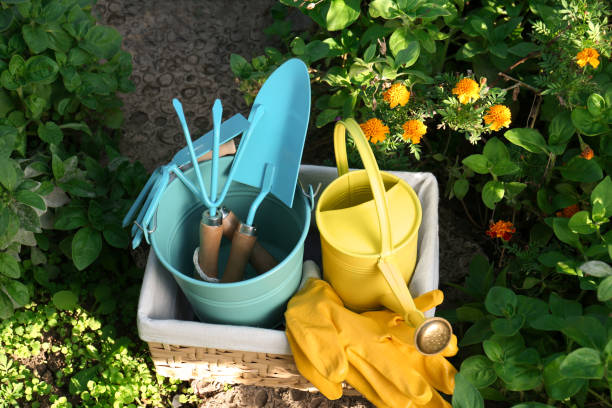
Thinking of starting a garden or turning your home into a jungle? Not only can gardening provide exactly what you need to relax and unwind, but getting started is easy- even for a beginner! All that's required is a few important tools and some know-how. Let's discuss plant care tools and what you'll require for gardening needs first.
1. Using a spray bottle will help reduce the amount of water required for certain plants.
Bluetooth Garden Watering Timers need extra humidity, which can be aided by using a spray bottle or mister. Look for a plant-grade spray bottle that delivers an ultra-fine mist. This will feel the gentlest on delicate plants, and the small particles will be the easiest to absorb. A spray can also be extremely handy when used to water seedlings or newly-potted young plants that can struggle with the heavy water from a watering. You may also utilize a mister for removing dust from leaves. Avoid getting plants with unusually water-sensitive leaves, particularly the African Violet.
2. Using a watering can (with a long spout) can make gardening easier.
Using a watering can make gardening tasks a lot easier. Using just a en cup, it's far too easy to accidentally spill water. Not only this, but without a watering can that's precisely calibrated, even parts of plants meant to stay dry will inevitably be prone to getting splashed. Using this can result in leaf scalding, root rot, and other undesirable side effects. A watering container permits you to apply the water directly onto the soil, which is safer. As many houseplants need watering from either the crown/base, selecting watering cans that have a long and narrow spout will facilitate controlling the water flow.
3. Using a pruner is essential for maintaining plants.
Pruning is a fundamental part of maintaining plants, and for this, you'll require a gardening pruner (also known as pruning shears). These are commonly employed to prune sick or dead plant tissue, as well as to control fast-growing and potentially invasive plants. Moreover, pruning spent flowers can stimulate plants to produce new blooms quicker. Carbon steel is the best pruner that's durable and extra-sharp, ideal for sniping quickly and precisely.
4. Pruning can be performed using scissors.
Pruning scissors are at a gardening match (and win!) when it comes to pruning, cutting hard-to-reach places, and removing dead flowers or leaves. This tool can be used to make the finest cuts, making it ideal for preserving herbs! Choose rust-resistant trimming scissors that deliver a sharp, clean cut to your houseplant.
5. Cleaning a garden by hand or using a trowel.
Hand trowels can be used to replace a shovel in the garden. Considering all the jobs these can alleviate, they are a must-have in your toolbox and can truly become a lifesaver. These miniature instruments are ideal for digging holes for bulbs, pulling up weeds that make digging that much easier, and sowing fresh soil and fertilizer. Choose your garden trowell based on your comfort, and remember to keep an eye out for ultra-comfy, cushion-grip handles!
6. A Hand Forking For Gardening is required.
Another useful gardening tool is a hand fork, which can be used to grate and chop vegetables. Hand trowels can be compared to miniature shovels, whereas hand forks could be likened to miniature rakes. They are useful for helping to loosen, lift, and till the soil, thus making it easier to work Princess. A hand forklat is one of the best tools to simplify your task! To make gardening as pleasant as possible, opt for a lightweight, rust-resistant hand fork with a comfortable handle.
7. Using a humidifier is recommended to prevent dilution.
Some plants, especially those that are tropical, thrive in moist conditions. You may live far from where it's possible to naturally maintain this level of humidity. To adjust the humidity accordingly, place your plant in front of a humidifier that enhances the appearance of being in a tropical environment. Additionally, consider placing humidity-lovers in a bathroom where showering is frequent. Remember that different types of plants require various levels of humidity, so it's recommended to test and measure the needs of each plant before installing any grow lights.
8. Grow with LEDs
Light is vital for cultivating a flourishing garden. An grow lamp is ideal for rooms that are under-lit or during dark, rainy seasons. Pay attention to models that offer a diverse light spectrum to plants, which can effectively boost growth and development year-round.
9. A soil tester is required.
Using a high-quality soil tester is useful for maintaining your plants' health and keeping them moist. Soil testers can be used to test the soil moisture level to determine if the plant is receiving enough water. There are models that come with extra functions for measuring soil pH, sunlight, and temperature – all of these care considerations rolled into one.
10. When gardening benches, gloves are recommended.
When gardening, it's natural to keep your hands protected from prickly leaves and thorns. Pay attention to the comfort and durability of choosing landscaping gloves, as well as whether they provide a "natural grip" and protect enough against scratches and cuts.
